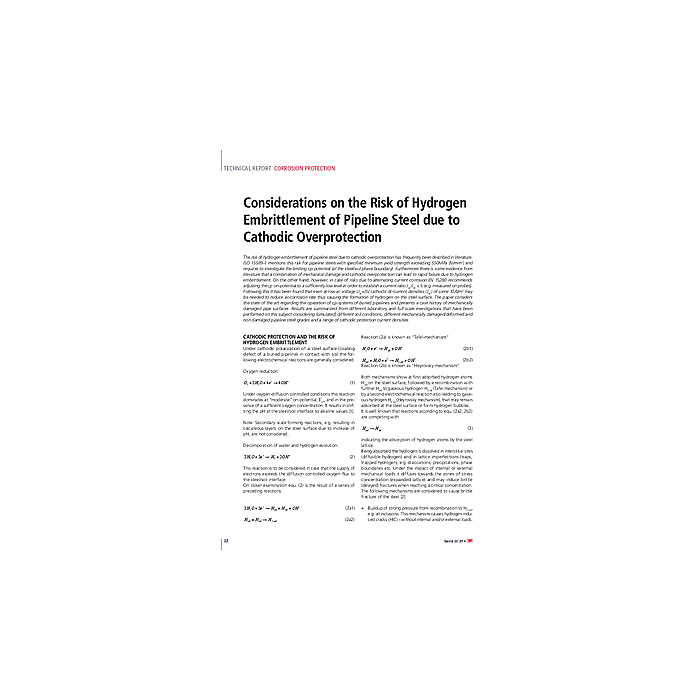Considerations on the Risk of Hydrogen Embrittlement of Pipeline Steel due to Cathodic Overprotection
€4.90
In stock
article number
01252_2014_SP2_04
The risk of hydrogen embrittlement of pipeline steel due to cathodic overprotection has frequently been described in literature. ISO 15589-1 mentions this risk for pipeline steels with specified minimum yield strength exceeding 550MPa (N/mm2) and requires to investigate the limiting cp-potential (at the steel/soil phase boundary). Furthermore there is some evidence from literature that a combination of mechanical damage and cathodic overprotection can lead to rapid failure due to hydrogen embrittlement. On the other hand, however, in case of risks due to alternating current corrosion EN 15280 recommends adjusting the cp on-potential to a sufficiently low level in order to establish a current ratio Jac/Jdc < 5 (e.g. measured on probes). Following this it has been found that even at low ac voltage Uac≈5V cathodic dc-current densities (Jdc) of some 10A/m2 may be needed to reduce ac-corrosion rate thus causing the formation of hydrogen on the steel surface. The paper considers the state of the art regarding the operation of cp-systems of buried pipelines and presents a case history of mechanically damaged pipe surfaces. Results are summarized from different laboratory and full scale investigations that have been performed on this subject considering (simulated) different soil conditions, different mechanically damaged/deformed and non damaged pipeline steel grades and a range of cathodic protection current densities.
| Authors | Hanns-Georg Schöneich |
|---|---|
| Publishing Date | 29 Aug 2014 |
| Format | |
| Zeitschrift | 3R - Special 2 2014 |
| Publisher | Vulkan-Verlag GmbH |
| Language | English |
| Pages | 8 |
| Title | Considerations on the Risk of Hydrogen Embrittlement of Pipeline Steel due to Cathodic Overprotection |
| Description | The risk of hydrogen embrittlement of pipeline steel due to cathodic overprotection has frequently been described in literature. ISO 15589-1 mentions this risk for pipeline steels with specified minimum yield strength exceeding 550MPa (N/mm2) and requires to investigate the limiting cp-potential (at the steel/soil phase boundary). Furthermore there is some evidence from literature that a combination of mechanical damage and cathodic overprotection can lead to rapid failure due to hydrogen embrittlement. On the other hand, however, in case of risks due to alternating current corrosion EN 15280 recommends adjusting the cp on-potential to a sufficiently low level in order to establish a current ratio Jac/Jdc < 5 (e.g. measured on probes). Following this it has been found that even at low ac voltage Uac≈5V cathodic dc-current densities (Jdc) of some 10A/m2 may be needed to reduce ac-corrosion rate thus causing the formation of hydrogen on the steel surface. The paper considers the state of the art regarding the operation of cp-systems of buried pipelines and presents a case history of mechanically damaged pipe surfaces. Results are summarized from different laboratory and full scale investigations that have been performed on this subject considering (simulated) different soil conditions, different mechanically damaged/deformed and non damaged pipeline steel grades and a range of cathodic protection current densities. |
Write Your Own Review

